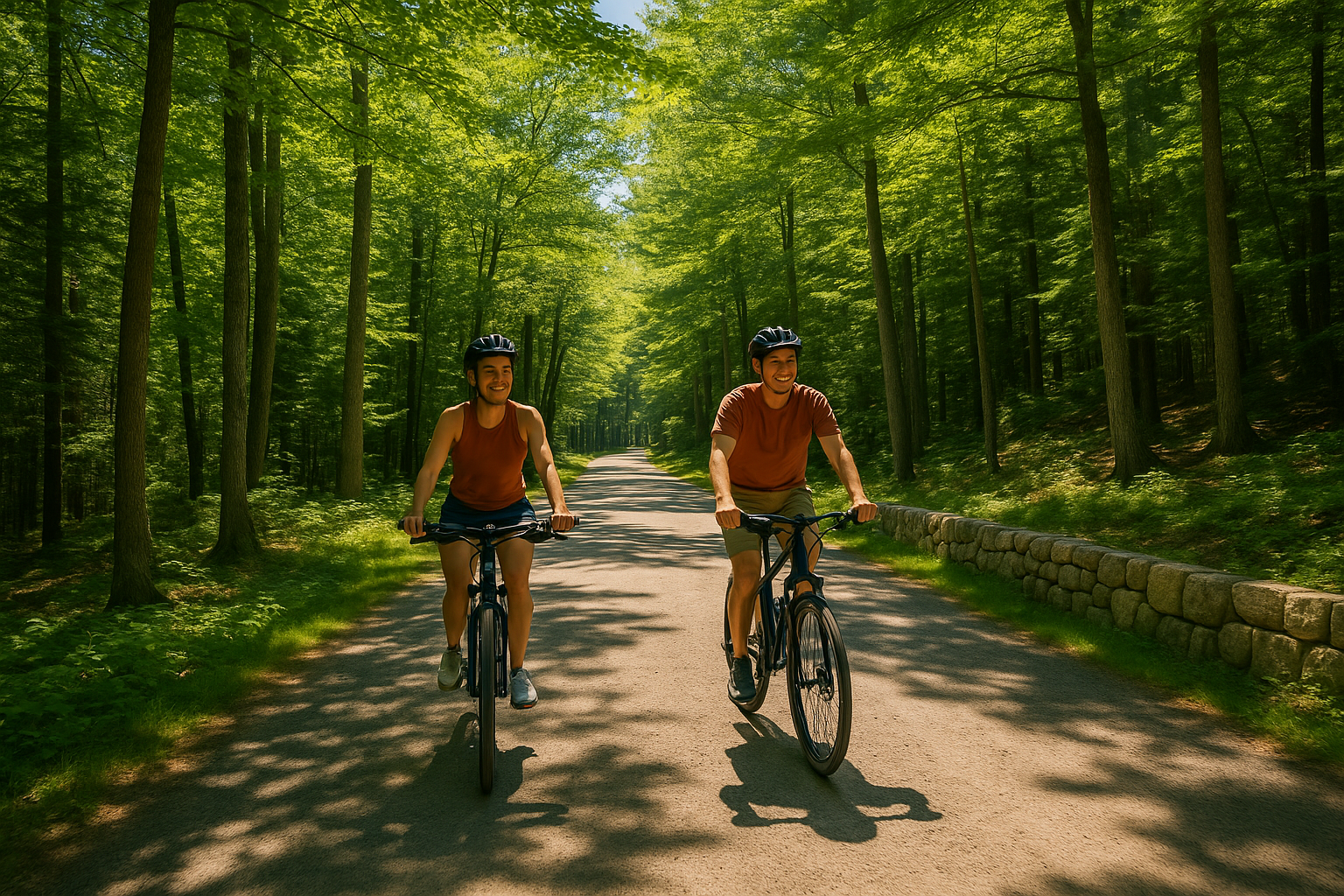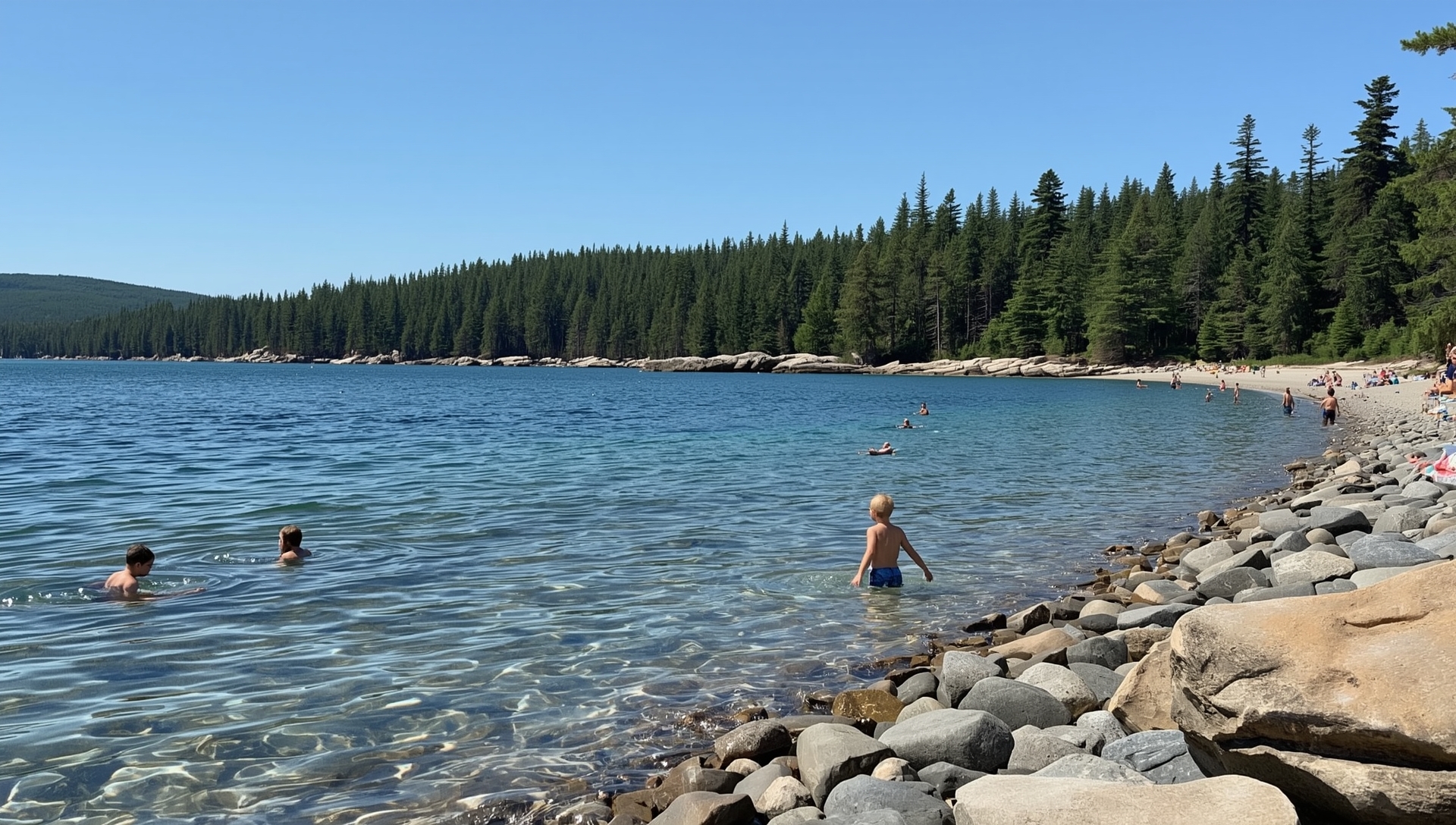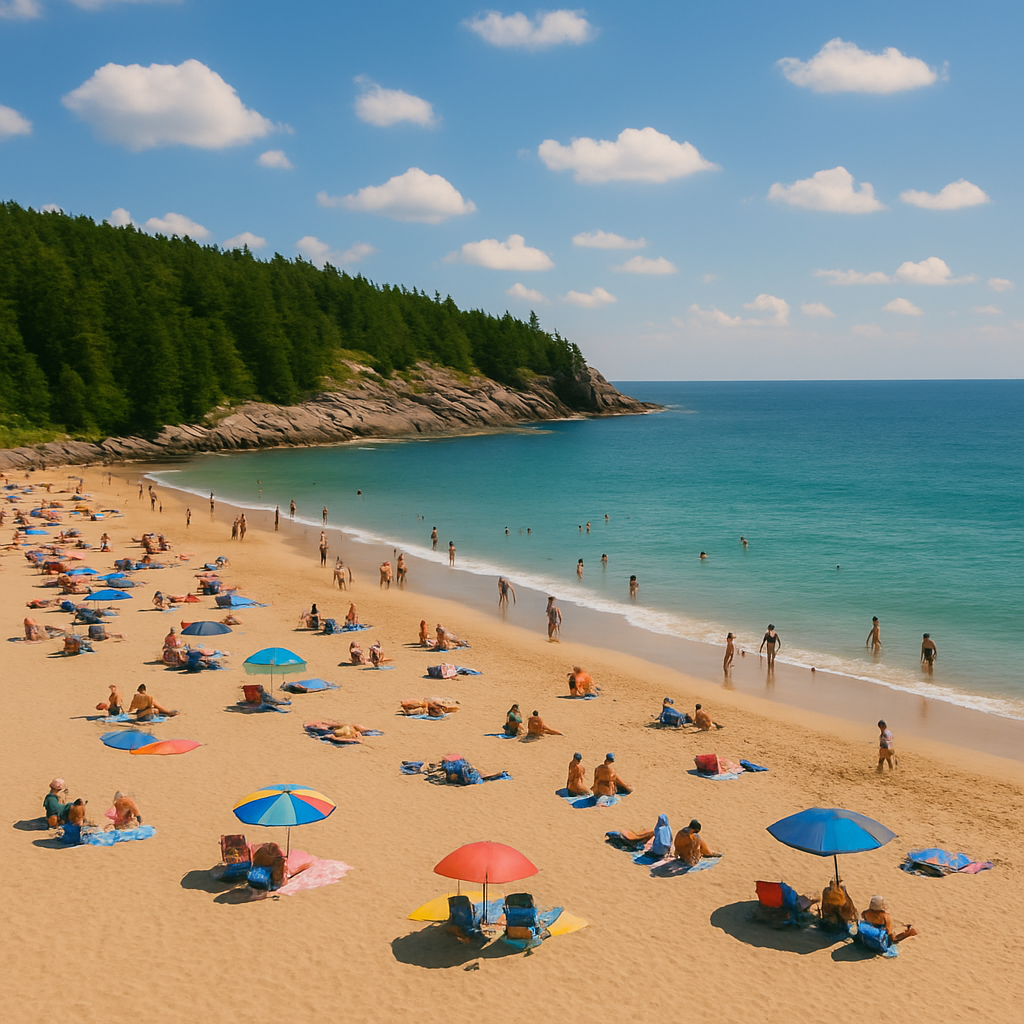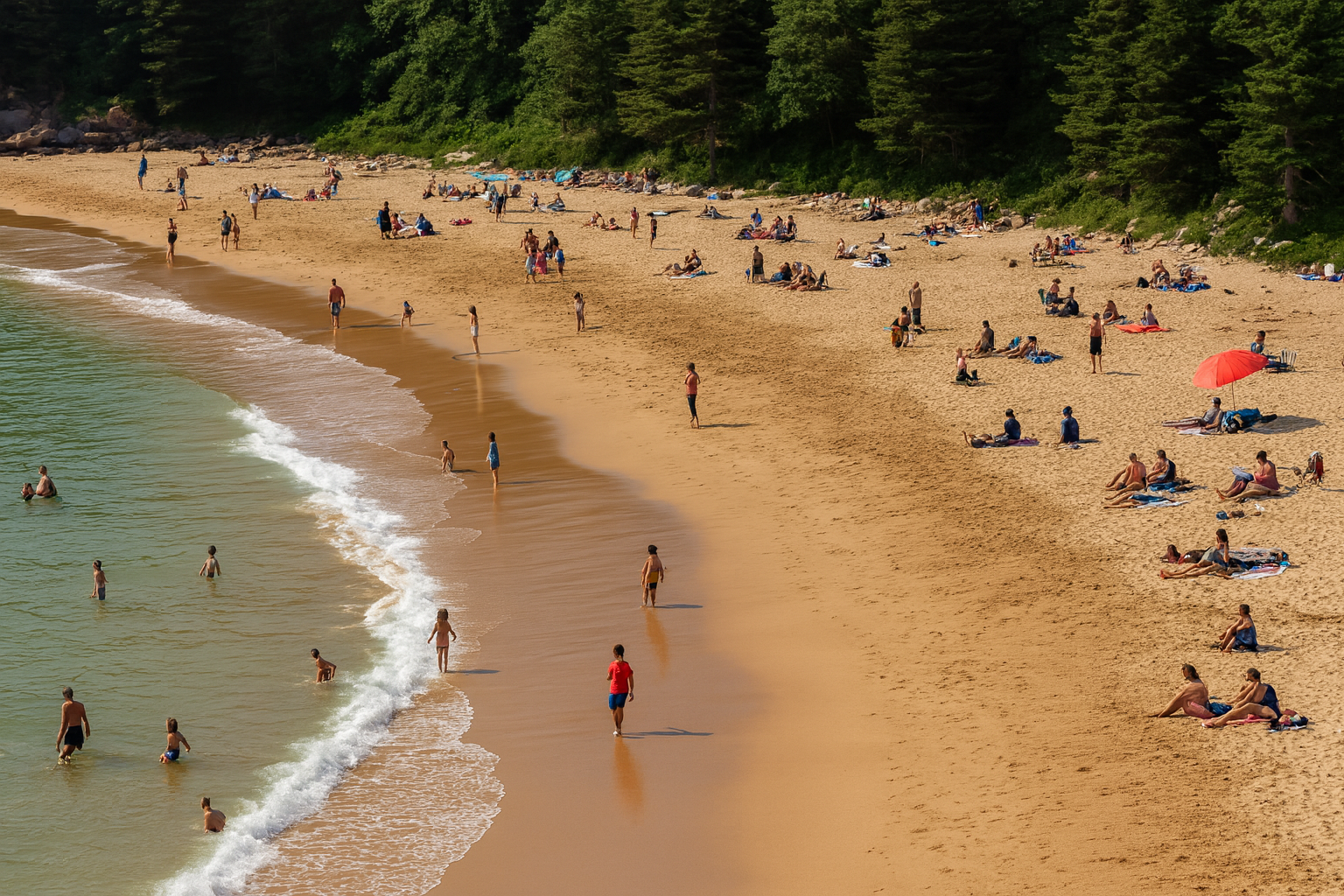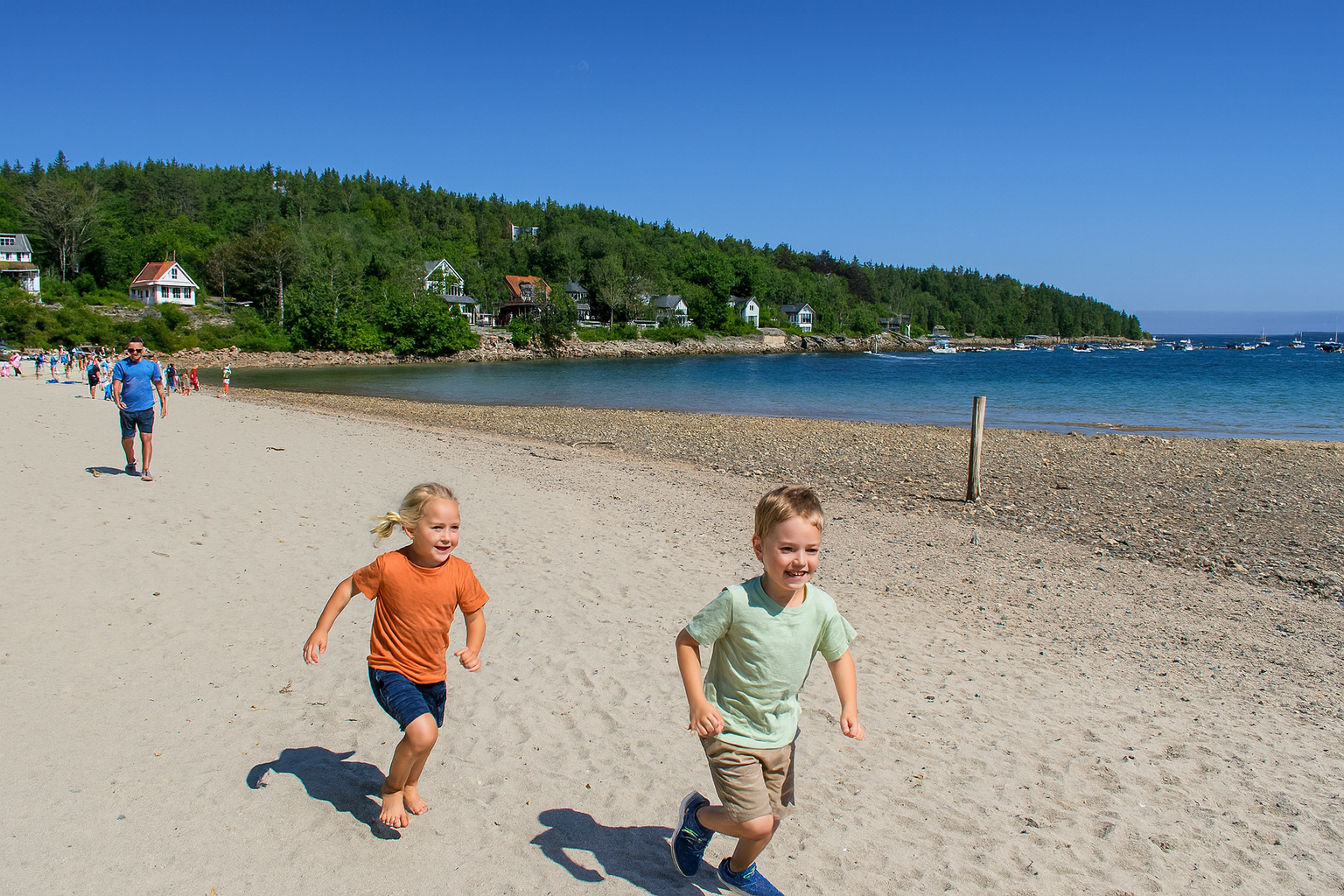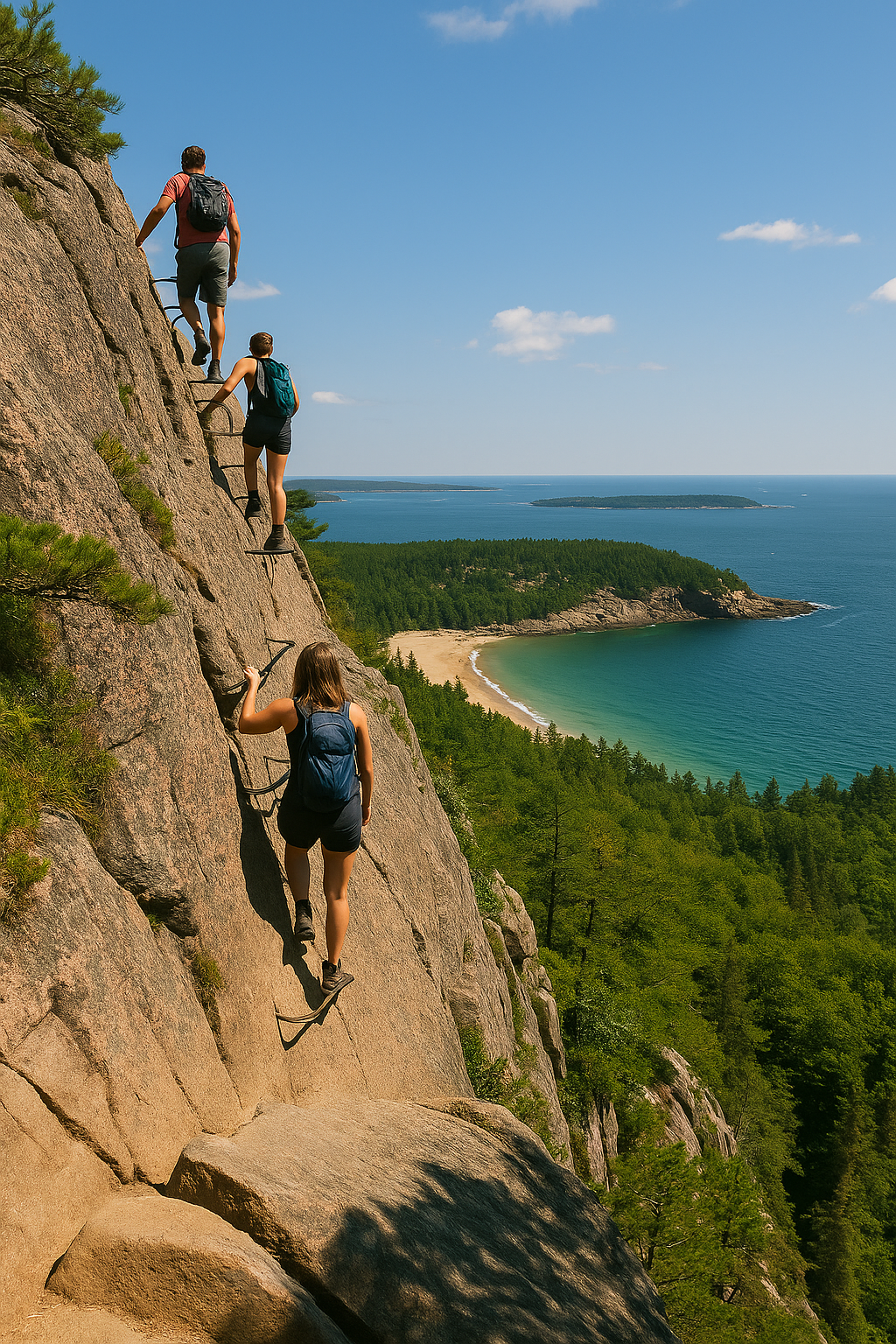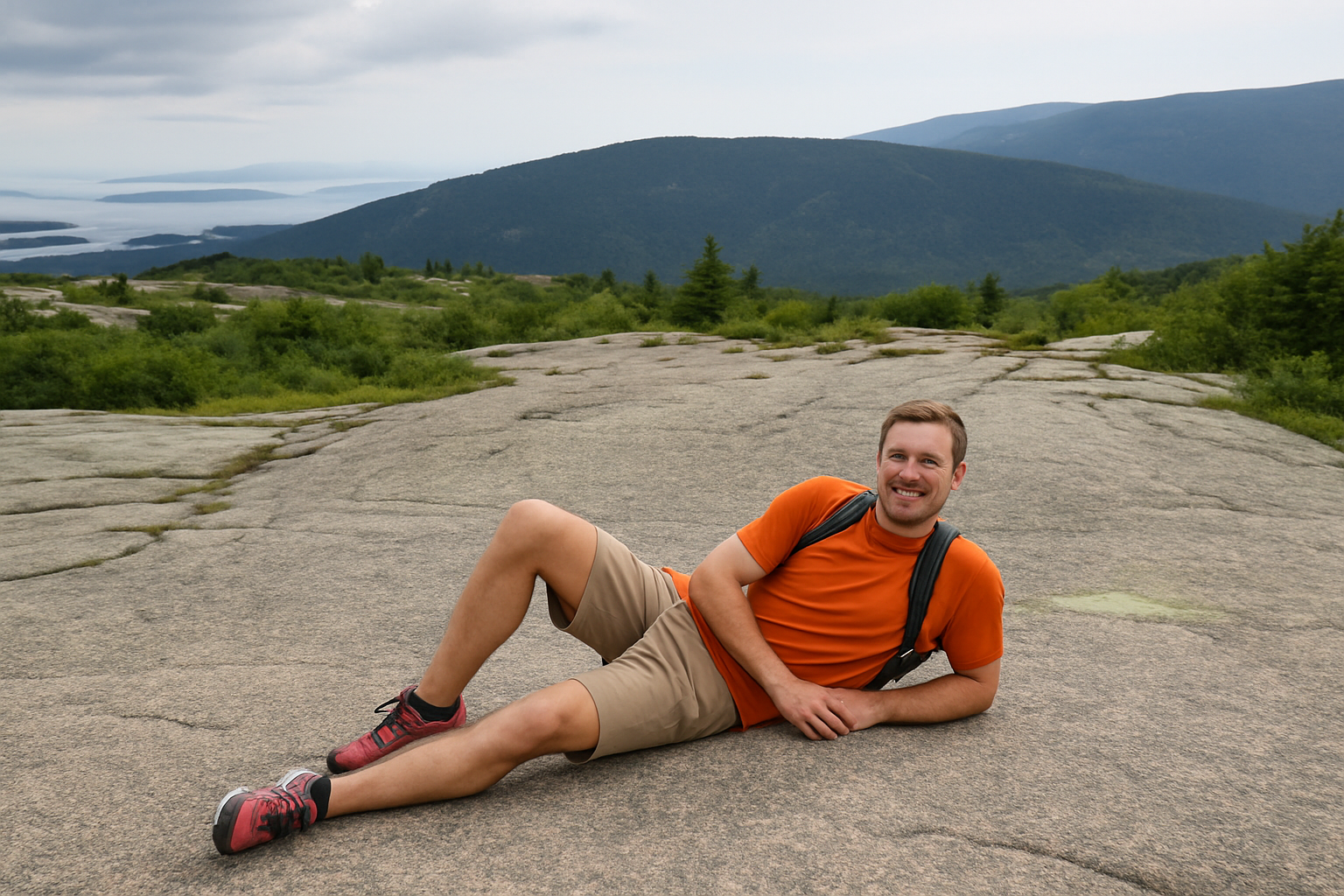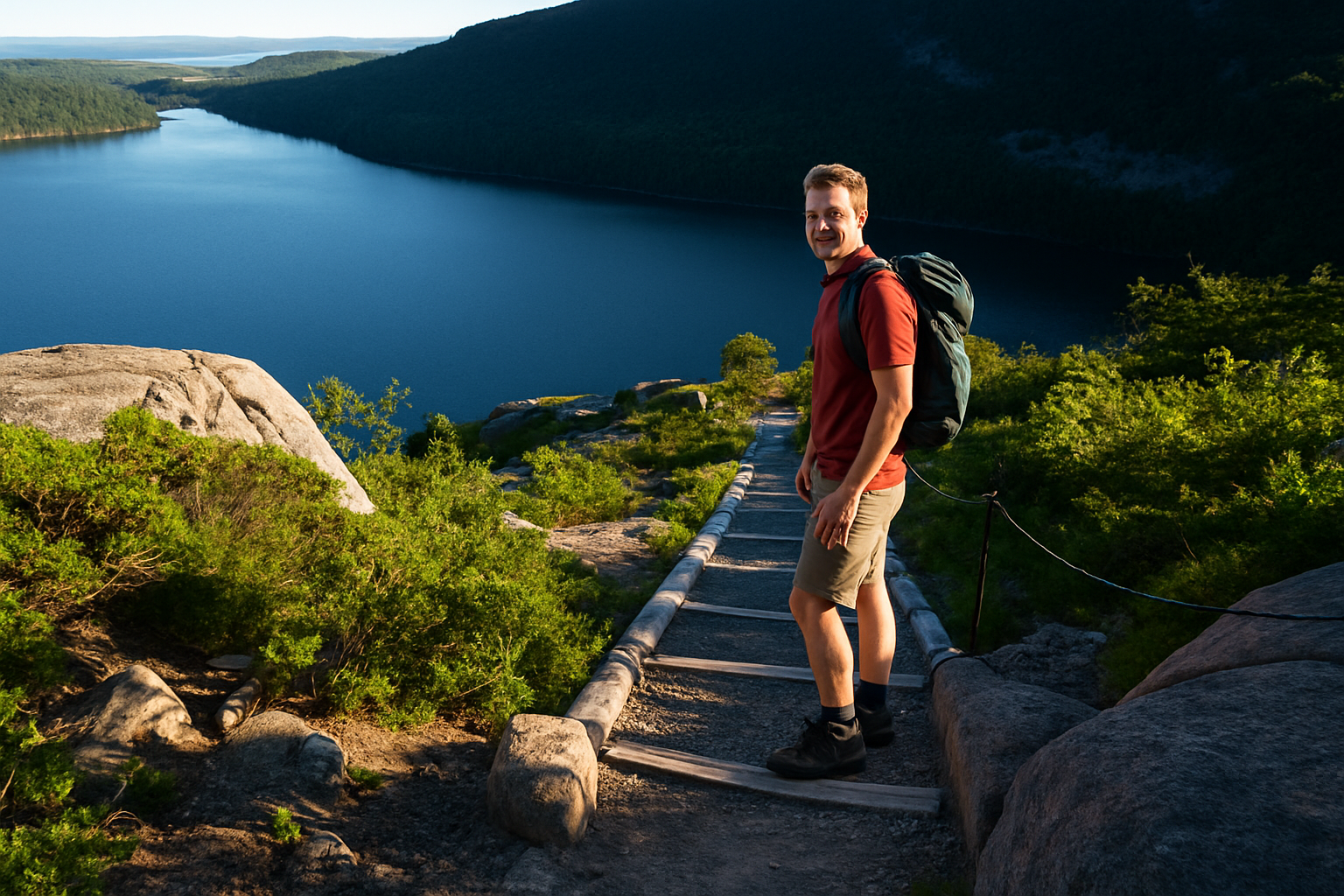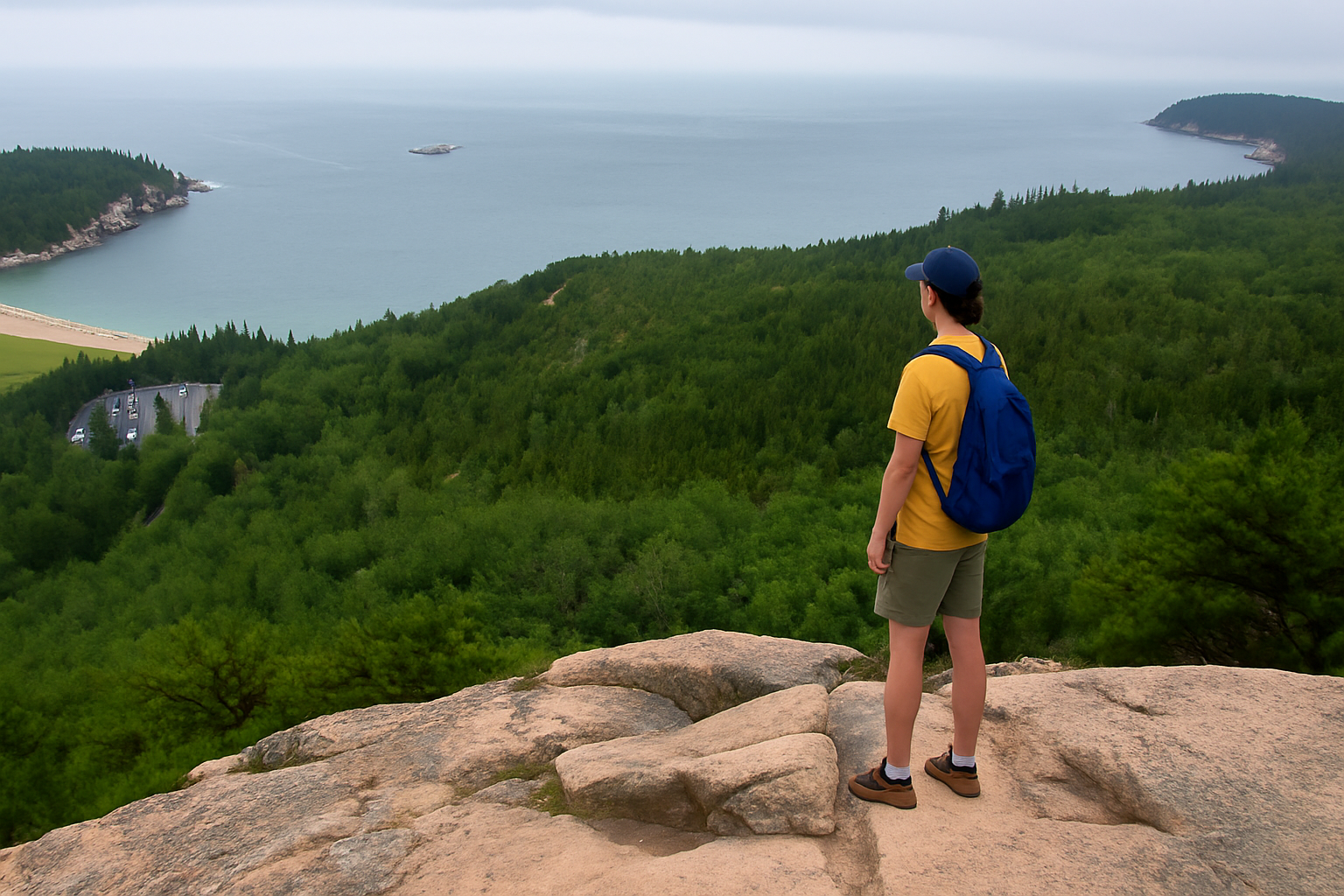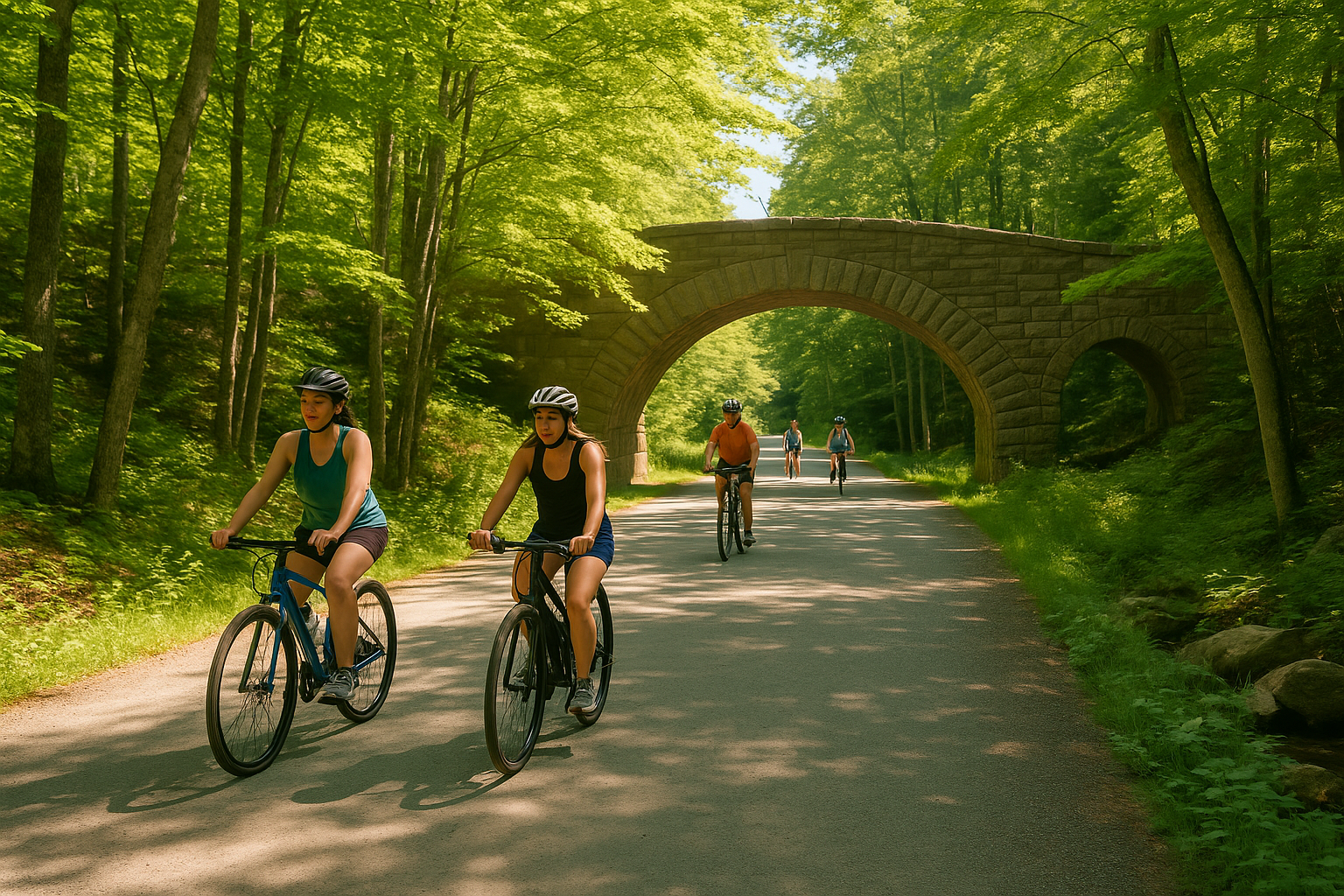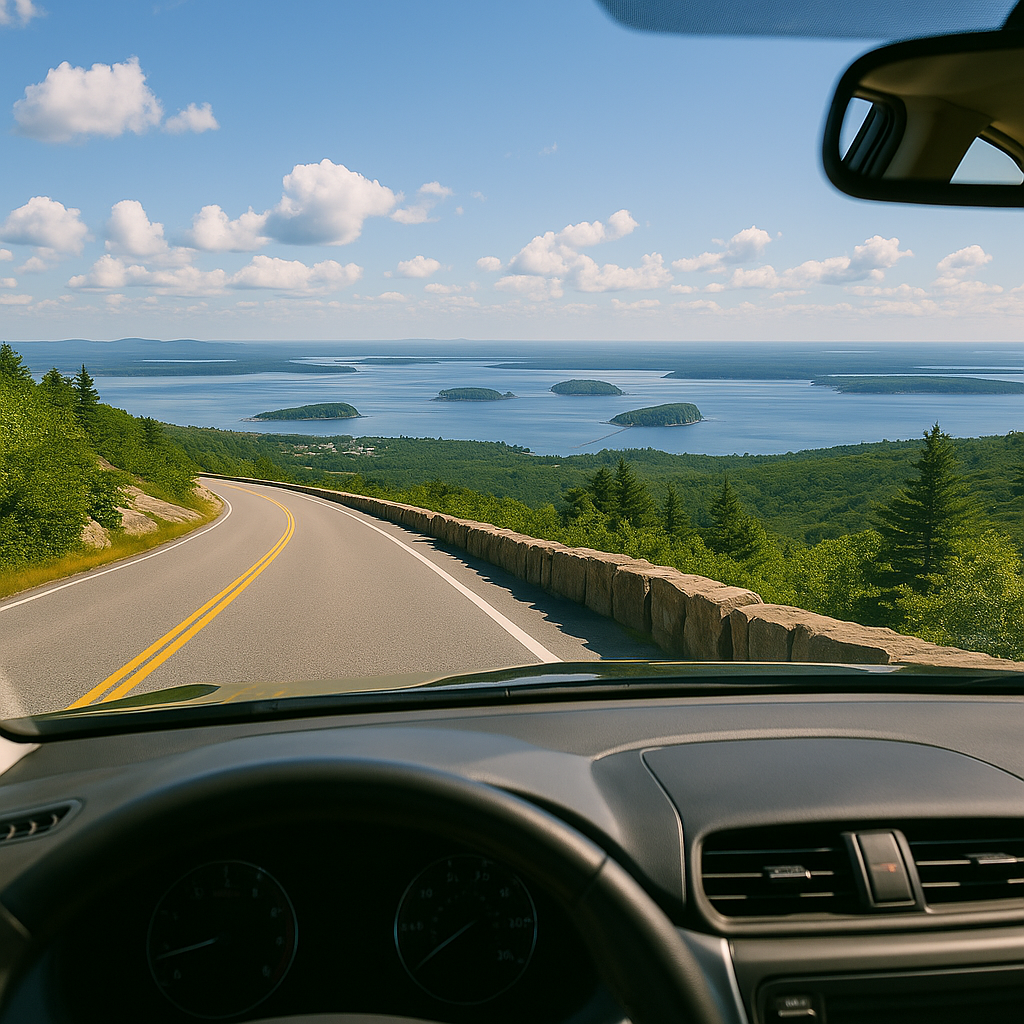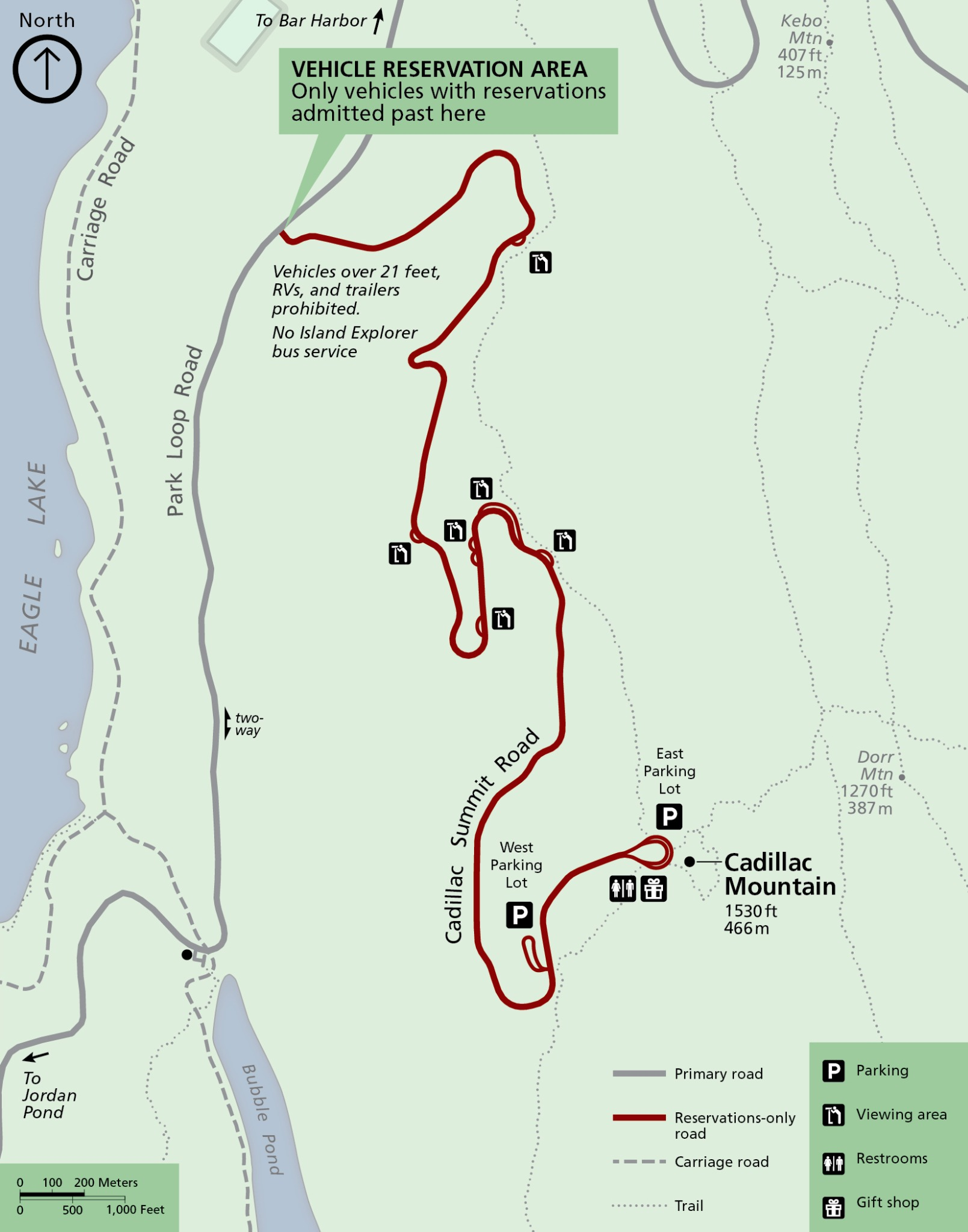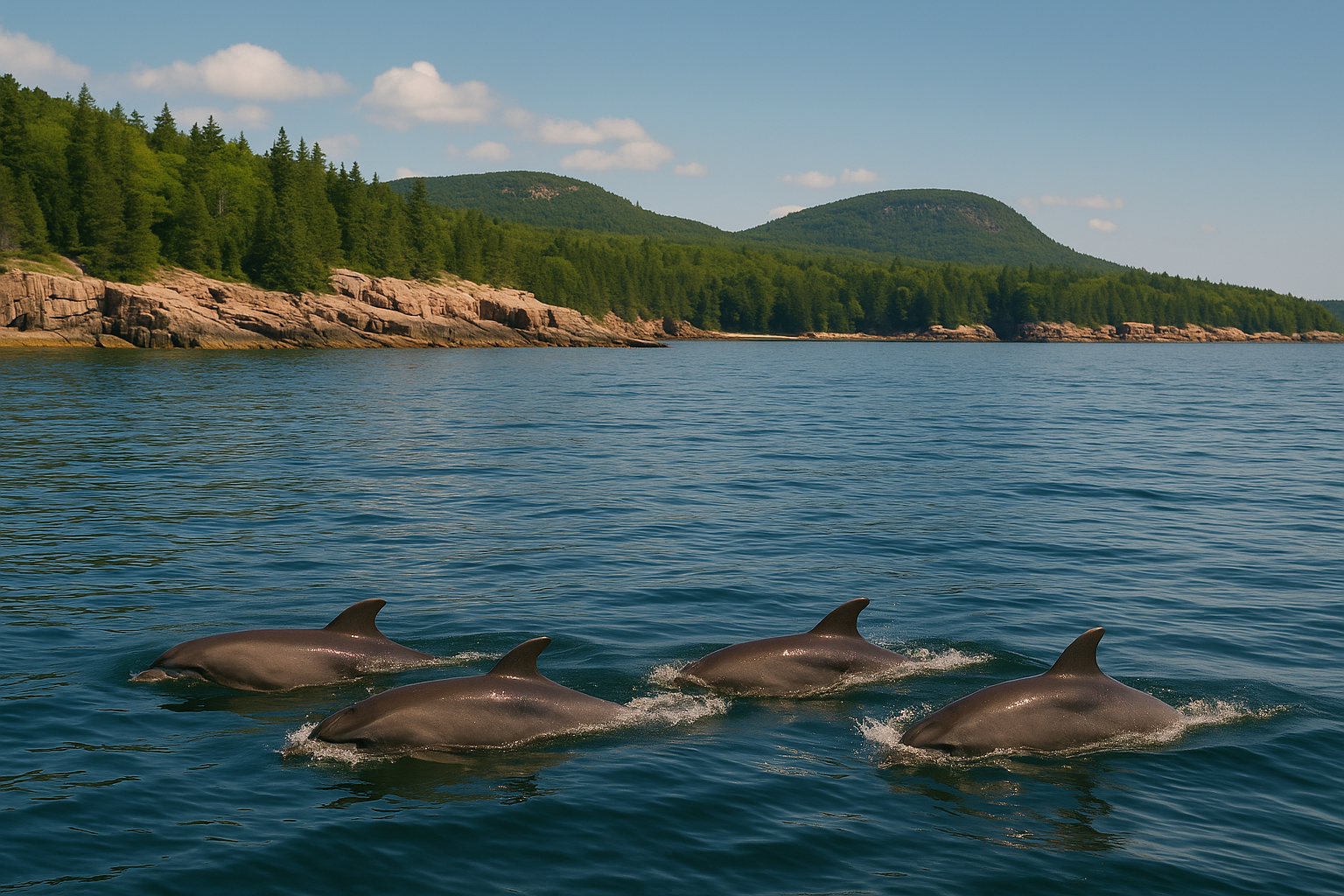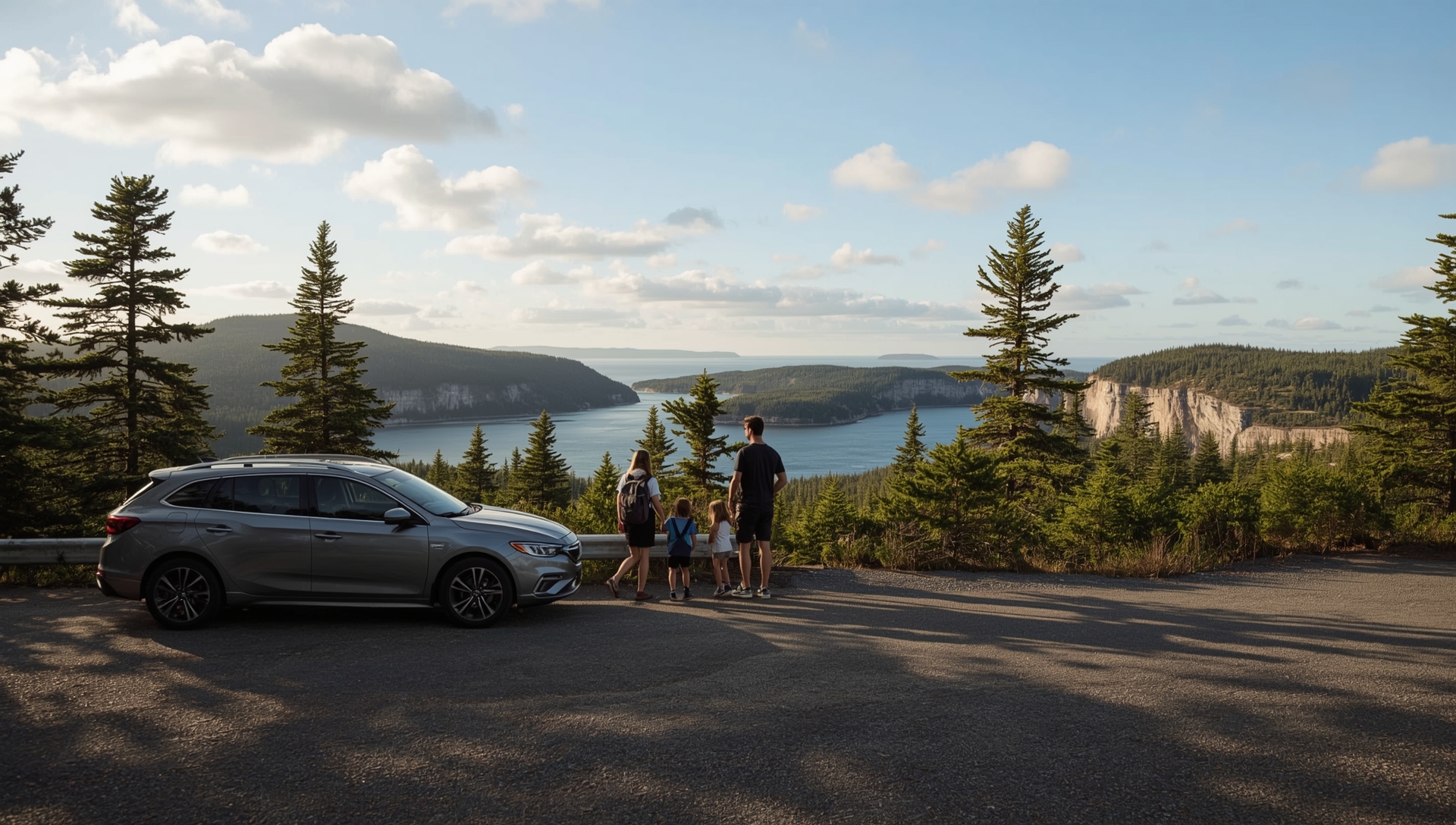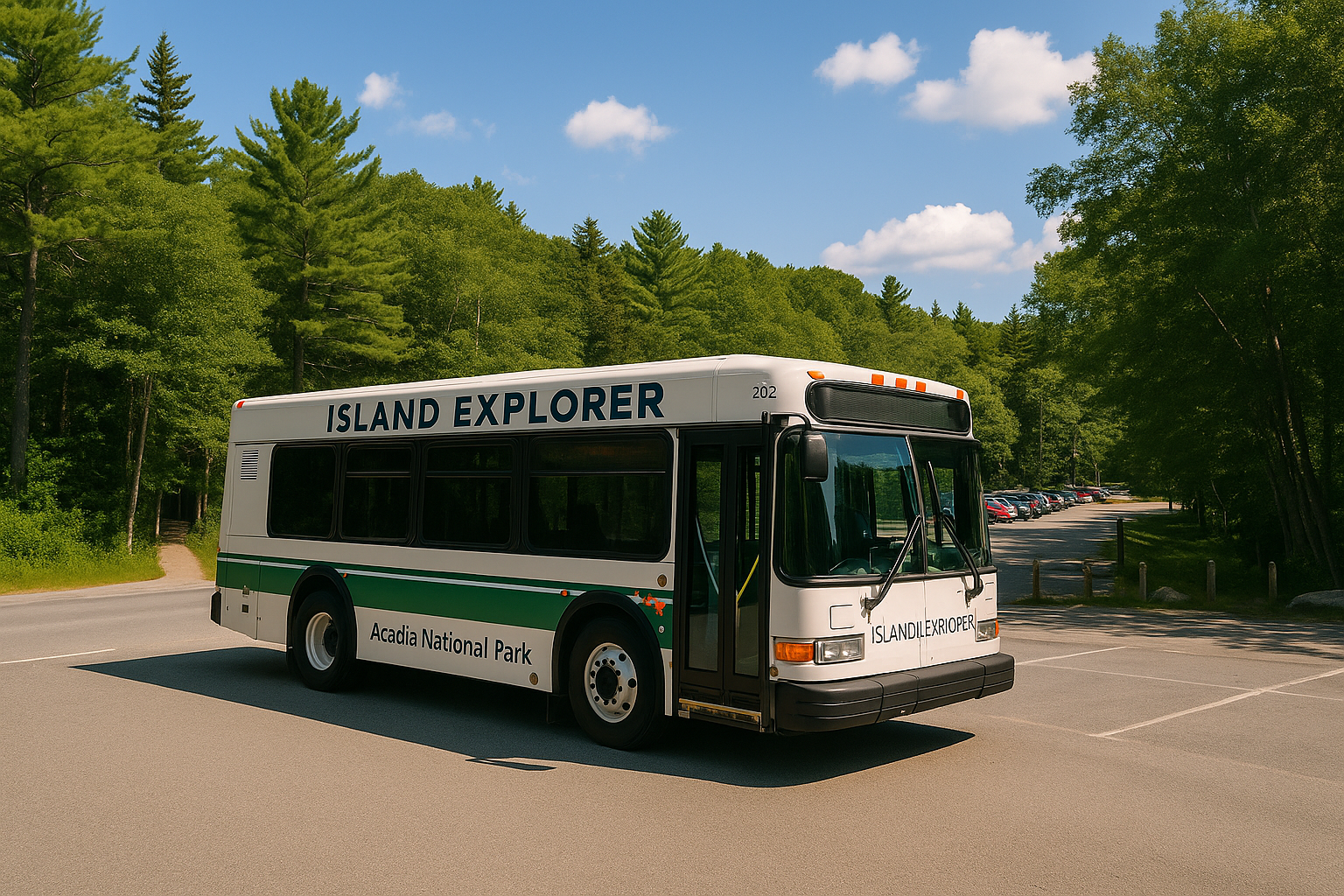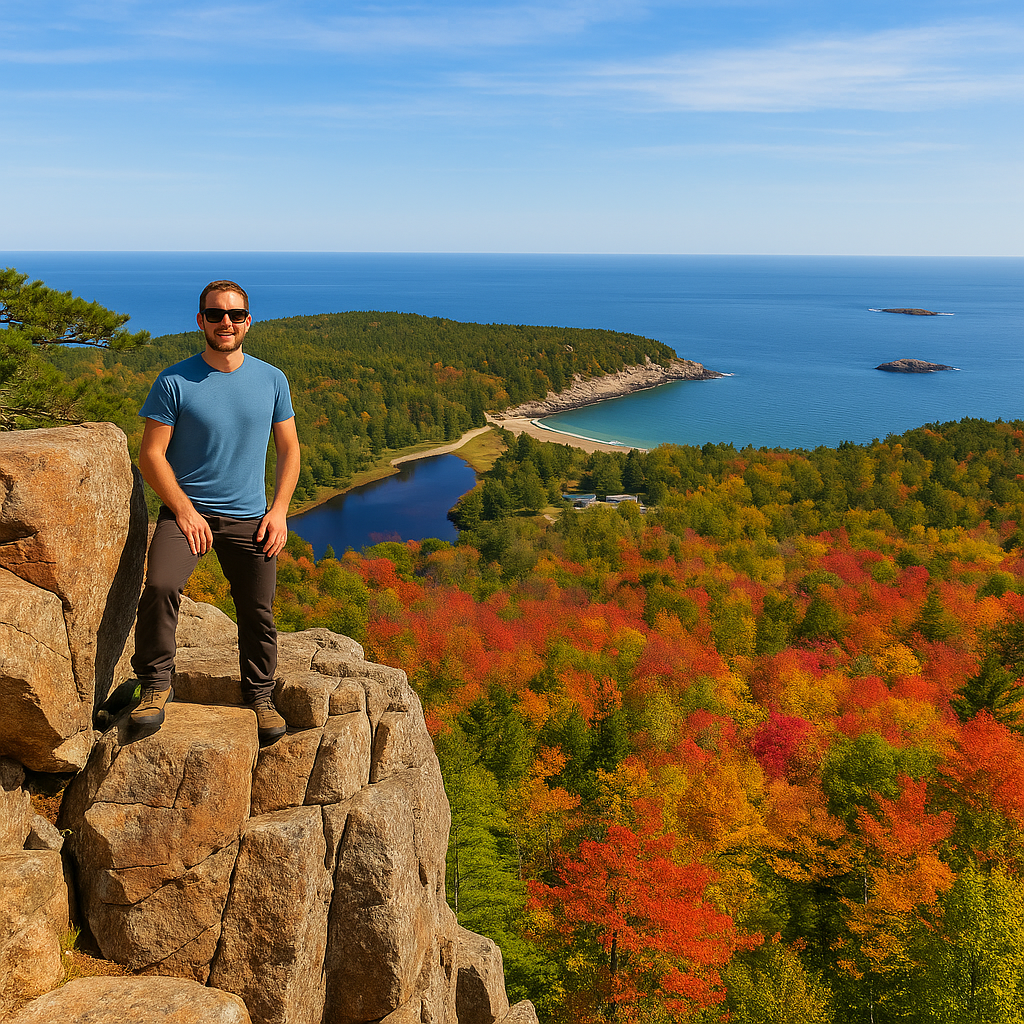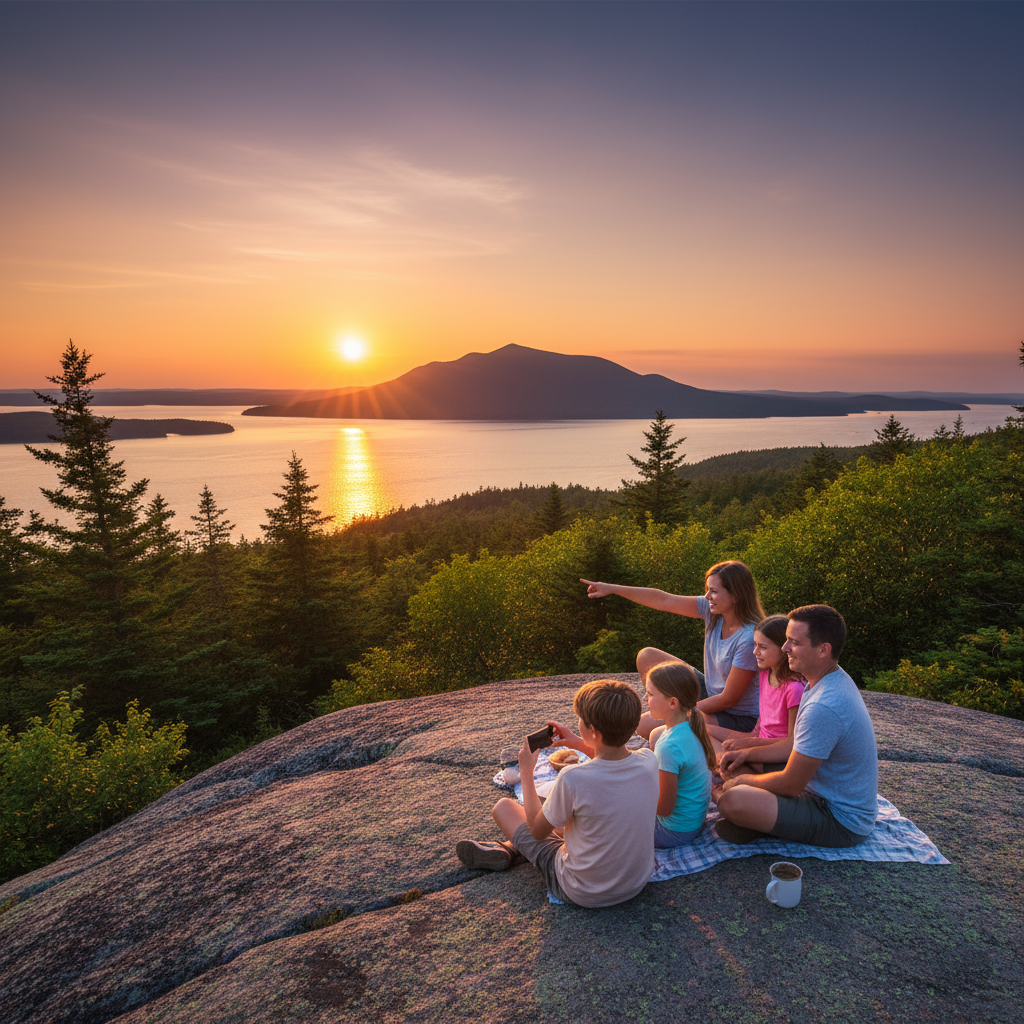Acadia National Park in Summer
Maine’s Wild Coast Comes Alive
Acadia National Park in summer is when Maine truly shines. The park hums with life under long hours of daylight, as ocean breezes roll through pine forests and the granite peaks of Mount Desert Island glow gold in the sun. Trails sparkle after morning fog lifts, waves crash against the rugged shoreline, and wildflowers fill the meadows along carriage roads.
It’s the season that defines Acadia summer — when families splash at Echo Lake Beach, hikers greet the sunrise from Cadillac Mountain, and cyclists trace stone bridges built more than a century ago. Campgrounds buzz with early risers cooking breakfast, and Bar Harbor comes alive with harbor strolls and café chatter.
From tide-pooling and bird-watching to scenic drives on Park Loop Road, every corner of the park feels touched by light and energy. Evenings cool gently, turning perfect for fireside chats or twilight walks along the water. Whether you come for a week or a weekend, acadia national park in summer captures that rare mix of coast, forest, and mountain that keeps visitors returning year after year.
• Experience Acadia National Park in summer with long days and cool ocean breezes.
• Plan your Acadia summer vacation around beaches, hikes, and scenic drives.
• Discover Acadia National Park summer activities like cycling, kayaking, and bird watching summer acadia.
• Visit top spots like Sand Beach, Echo Lake, and Cadillac Mountain.
• Make the most of warm weather, golden sunsets, and unforgettable coastal views.
Why Visit Acadia National Park in Summer?
There’s a reason travelers say Acadia National Park in summer is the most magical way to experience Maine’s coast. The season brings out everything that makes Acadia special — endless daylight, fresh ocean air, and the perfect balance of adventure and calm. When the snow has long melted and the spring rains fade, the park opens up completely. Trails once closed to protect nesting wildlife are ready to explore, and the carriage roads stretch out under green canopies that seem to glow in the sunlight. Morning mist rolls off the Atlantic, leaving the cliffs shining, and the forests hum with life.
The weather alone makes summer irresistible. Days sit comfortably between 65 and 80°F, perfect for hiking or cycling without the extremes of heat or cold. Nights cool down just enough for cozy campfires and stargazing sessions. It’s no wonder that many travelers plan their Acadia National Park summer vacation around this time — the conditions couldn’t be better. You can fill your days with long hikes, swims, and scenic drives, then relax each evening under a soft pink sky reflected in Frenchman Bay.
Bar Harbor transforms in summer, too. The town comes alive with energy as visitors return from the trails and share stories over dinner. Outdoor music drifts through the streets, cafés spill out onto sidewalks, and the smell of fresh seafood mingles with sea salt in the air. The free Island Explorer shuttle makes it easy to get around without worrying about parking, connecting the town to campgrounds, beaches, and trailheads across the park.
And yet, even at the height of the season, there are still places to find peace. An early-morning walk along Ocean Path before sunrise feels calm and unhurried. An afternoon paddle on Long Pond reveals quiet coves where loons call across the water. The Schoodic Peninsula, on the park’s eastern edge, offers dramatic waves and solitude far from the crowds. That mix of energy and serenity defines Acadia National Park summer — a time when both the park and its visitors feel fully awake.
Wildlife lovers will find this the best time for bird watching summer acadia, as songbirds, eagles, and puffins are most active. Families can explore tide pools, couples can take sunset cruises, and solo travelers can lose themselves on the carriage roads beneath the trees. With its unbeatable weather, vibrant communities, and breathtaking scenery, summer in Acadia isn’t just a season — it’s the park at its peak.
• Warm days (65–80°F) and cool nights — perfect for hiking, camping, and photography.
• All major Acadia National Park summer activities are open: beaches, trails, carriage roads, and ranger programs.
• Acadia National Park summer vacation season means shuttles, ferries, and visitor centers running daily.
• Excellent for bird watching summer acadia — puffins, eagles, and coastal seabirds.
• Try kayaking, scenic cruises, or cycling under shady green carriage roads.
• Don’t miss the Acadia Night Sky Festival and ranger-led nature walks.
Best Beaches to Cool Off in Acadia National Park
From Granite Peaks to Golden Sand
Acadia National Park in summer isn’t only about rugged mountains and pine-covered trails — it’s also a place to kick off your shoes and feel cool sand between your toes. When the midday sun warms the granite ridges and the tide rolls gently onto Mount Desert Island’s rocky coast, the beaches become welcome sanctuaries. Though Maine’s waters stay brisk, the contrast between sun-warmed rock and Atlantic spray is part of Acadia’s unique charm.
Across the park, a handful of shorelines offer something for every kind of visitor. Families settle near calm freshwater lakes where kids can swim safely; adventurers head to open-ocean beaches framed by cliffs; photographers wait for that perfect mix of sunlight, mist, and reflections on the water. Whether you’re after a quick dip, a picnic by the surf, or just a quiet place to watch the waves, these beaches add a softer rhythm to the excitement of Acadia National Park in summer.
🏖️ Sand Beach Acadia
Nestled between rugged headlands and spruce forest, Sand Beach Acadia is Acadia’s most iconic stretch of shoreline — a golden crescent carved into the cliffs of Mount Desert Island. The sand itself is a mix of crushed shells and fine grains, soft underfoot yet edged by massive granite outcrops that glow pink at sunrise. Standing here, you can smell the salt and pine mingling in the air while the surf rolls in with steady, echoing rhythm. It’s small — just under 300 yards long — but every step feels cinematic.
Despite its postcard beauty, the water is famously chilly. Even in midsummer, temperatures hover around 55°F, which makes a quick swim both bracing and unforgettable. Many visitors dip in just once for the thrill, then warm up by strolling along the Ocean Path that starts at the far end of the beach. This trail winds past Thunder Hole and leads toward Otter Cliff, offering panoramic ocean views and seabird sightings along the way.
Morning is the best time to arrive. The light is soft, the air still, and the parking lot near the Sand Beach entrance fills slowly. By late morning, especially in July and August, spaces vanish fast — though the Island Explorer shuttle makes access easy without the stress of finding a spot.
Families spread towels across the sand while kids build fortresses at the water’s edge. Couples perch on driftwood logs to watch the surf break against the rocks, and photographers capture that perfect frame of cliffs and foam. From the beach itself, you can look north toward Cadillac Mountain, its rounded summit catching the same sunlight that glints off the waves. It’s the ideal reminder that Acadia’s beauty stretches seamlessly from mountaintop to shoreline.
• Location: Off Park Loop Road between Great Head and Thunder Hole
• Water temperature: 50–55°F (refreshing Atlantic dip!)
• Length: ~290 yards of fine sand
• Facilities: Restrooms, changing areas, and lifeguards in summer
• Best time: Early morning for calm light and smaller crowds
• Parking: Limited — use the Island Explorer shuttle if lots are full
• Nearby walks: Ocean Path → Thunder Hole → Otter Cliff
Echo Lake Beach
If Sand Beach is Acadia’s dramatic coastal showpiece, Echo Lake Beach is its calm, sun-warmed retreat. Tucked beneath the cliffs of Beech Mountain, this freshwater beach feels worlds away from the chill of the Atlantic. The sand here is soft and golden, and the clear lake water gradually deepens from pale green to dark sapphire as it reflects the forested hills. On still mornings, the entire mountain mirrors perfectly across the surface, broken only by the occasional ripple of a paddleboard or a diving loon.
Unlike the ocean beaches, Echo Lake Beach Acadia National Park warms comfortably through summer, often reaching the high 60s °F by mid-season — practically tropical by Maine standards. Families flock here for that reason: kids can wade safely in the designated swimming area watched by lifeguards, while parents lounge nearby with picnic blankets and paperbacks. The lake bottom slopes gently, making it ideal for younger swimmers and anyone looking for a leisurely float.
Adventure seekers love Echo Lake too. From the far end of the beach, trails lead toward Beech Cliff and Canada Cliff, offering short, scenic climbs with stunning lake-to-ocean vistas. Kayakers and paddleboarders often launch from the western side, gliding past rocky inlets fringed with pine. Even in peak season, it rarely feels crowded; there’s a relaxed rhythm here — laughter carrying across the water, dragonflies hovering above the reeds, and sunlight flickering through the treetops.
Early afternoon is perfect for a swim, when the water is warmest and the sun catches the mountain ridge above. By evening, families pack up and the mood softens again, leaving a quiet mirror of colors on the water. Whether you come for the swim, the views, or the peace, Echo Lake Beach captures the gentler side of Acadia National Park in summer — a place to unwind after a long hike or simply drift and listen to the loons.
• Location: Southwest Harbor side of Mount Desert Island, off Route 102
• Water temperature: Mid-60s °F in July–August — much warmer than the Atlantic
• Lifeguards on duty daily during peak season
• Facilities: Restrooms, picnic area, and ample shade under pines
• Arrive before 10 a.m. for parking near the shoreline lot
• Nearby hikes: Beech Mountain Trail & Canada Cliff Loop for panoramic views
• Great for: Families, paddleboarding, picnics, and gentle afternoon swims
Seal Harbor Beach
If Sand Beach is iconic and Echo Lake is relaxing, Seal Harbor Beach is intimate — a quiet curve of sand where the locals go to escape the summer crowds. Tucked along Mount Desert Island’s southern edge, this small crescent feels worlds away from Bar Harbor’s bustle. The water is the same Atlantic that meets Sand Beach, but the atmosphere here couldn’t be more different: slower, softer, and far more personal.
Seal Harbor Beach Acadia National Park is framed by rocky outcrops and shaded evergreens, with views that open toward Sutton Island and the distant outlines of boats crossing Frenchman Bay. The sand is a little coarser and the tide rolls in gently, leaving behind tiny shell fragments that sparkle under the sun. You won’t find big crowds or rows of umbrellas here — just a few scattered families, a couple of kayaks pulled ashore, and locals reading quietly with their feet in the surf.
This beach sits close to the southern entrance of the park and is easy to miss if you don’t know where to look. Most visitors head straight for Sand Beach, leaving Seal Harbor for those who prefer peaceful afternoons and natural beauty without the noise. At low tide, the sand stretches farther into the bay, revealing pools filled with periwinkles and small crabs — a treat for curious kids or photographers chasing reflections in the wet sand.
The charm of Seal Harbor lies in its simplicity. There are no lifeguards, food stands, or long lines — just the steady rhythm of the ocean and the cry of gulls circling overhead. Bring a blanket, a book, and maybe a light jacket for when the breeze picks up off the water. Stay until late afternoon, when the sun lowers behind the treeline and the cove glows in soft gold. It’s a timeless moment that reminds you why Acadia National Park summer isn’t only about adventure — it’s also about stillness, connection, and the kind of quiet that lingers long after you leave.
• Location: Route 3, southern end of Mount Desert Island, near Jordan Pond Road
• Parking: Small lot beside the harbor — arrive early or walk from nearby pull-offs
• Atmosphere: Quiet, local, and peaceful — rarely crowded, even in July
• Best time: Late afternoon for warm light and calm tides
• Facilities: None — bring snacks, water, and beach gear
• Bonus tip: Visit at low tide for tide pools and mirror-like sand reflections
• Nearby: Quick drive to Jordan Pond House or the Stanley Brook Entrance
Wrapping Up: Finding Your Perfect Beach Day
The beaches of Acadia National Park in summer show a softer side of this wild coastal landscape. Whether it’s the Atlantic spray at Sand Beach, the calm, sun-warmed shallows of Echo Lake Beach, or the quiet charm of Seal Harbor Beach, each place offers a different kind of escape. Together they capture the variety that defines Acadia summer — raw beauty, family moments, and peaceful hours where time seems to slow.
Whichever shoreline you choose, come prepared to savor it slowly. Bring sunscreen, water, and a light layer for the evening breeze. Keep an eye on the tide, watch for wildlife, and enjoy the mix of ocean and forest that makes Acadia one of the most distinctive national parks in the country.
For anyone planning an acadia national park summer vacation, these beaches belong at the top of the itinerary. They’re beautiful, accessible, and full of moments that stay with you long after the trip ends. Above all, remember the park’s rhythm depends on respect — leave no trace, pack out what you bring, and tread lightly so these stretches of sand and lake shore remain pristine for the next visitor. After all, Acadia’s beauty doesn’t just belong to this summer — it belongs to every season yet to come.
Hiking Trails in Summer
With more than 150 miles of paths weaving through granite peaks, forests, and rocky shoreline, acadia national park in summer is a hiker’s dream. The long, sunlit days open every trail in the park — from easy lakeside walks to steep iron-rung scrambles — and the warm weather makes exploring Acadia’s diverse landscapes pure joy. Whether you’re looking for forest shade, sweeping summit views, or quiet coastal tracks, summer is the season to lace up and go. The variety of acadia national park trails ensures there’s something for everyone: families, photographers, casual walkers, and diehard adventurers alike.
The best part about hiking in Acadia this time of year is the freedom to roam. Snow and mud are gone, the wind is mild, and every route — from the carriage roads to the cliffs — is open. Each day brings a new combination of trails to explore. You might spend one morning following the acadia national park hiking trails that circle Jordan Pond, and the next climbing sun-warmed granite toward Cadillac’s panoramic summit. Wherever you go, you’ll find that trails in Acadia National Park deliver that rare mix of mountain challenge and ocean calm.
Cadillac Mountain South Ridge Trail
The Cadillac Mountain South Ridge Trail is a summer essential — the classic Acadia climb and one of the park’s longest, most scenic routes. At roughly 7.5 miles round trip, it leads hikers from forest floor to the highest point on the U.S. Atlantic coast. The path winds through groves of spruce and fir, then opens onto wide pink-granite ridges dotted with low blueberry bushes and alpine flowers. In July, you might catch small patches of wild lupine or hear the distant cry of gulls from Frenchman Bay below.
Hiking Cadillac Mountain in summer means you’ll have clear skies, warm breezes, and panoramic views at every turn. The ocean stretches endlessly eastward, and islands scatter across the bay like steppingstones. It’s best to start early — before the granite heats under the midday sun — and you’ll often have the first mile nearly to yourself. The climb is steady but not steep, making it a favorite among experienced hikers and fit beginners alike.
From the summit, where granite domes roll down toward the sea, the reward is a 360-degree panorama — Bar Harbor to the north, Blue Hill Bay to the west, and open ocean to the east. For sunrise lovers, this is the ultimate Acadia experience, though you’ll need a permit for early access. Bring plenty of water and a camera: you’re standing on one of the most photographed peaks in America. The South Ridge is truly one of the best hiking trails in acadia for anyone chasing classic coastal summits and wide-open sky.
• Distance: 7.5 miles round trip
• Elevation gain: ~1,350 ft to the summit
• Difficulty: Moderate
• Trailhead: Route 3, just south of Blackwoods Campground
• Best time: Early morning or sunset for cooler temps and fewer crowds
• Highlights: Granite ledges, wild blueberries, sweeping ocean views
• Nearby: Mountains in Acadia National Park
Jordan Pond Path
If Cadillac is Acadia’s grand climb, the Jordan Pond Path is its quiet masterpiece. This gentle 3.3-mile loop circles one of the park’s most iconic lakes — crystal clear and framed by the twin peaks of North and South Bubble. The path alternates between wooden plank walkways, shady forest stretches, and open shoreline where sunlight sparkles on the water. It’s among the most accessible of the acadia national park hiking trails, perfect for families or anyone wanting a peaceful afternoon walk with postcard scenery.
Summer brings the pond to life. Loons call across the still surface, dragonflies drift above the reeds, and visitors pause along the path to take in reflections so perfect they look painted. Even at mid-afternoon, you can always find a quiet moment away from the bustle. The cool forest shade and gentle breeze off the water make this one of the best places to walk during warm July days.
Halfway around, you’ll find yourself at the doorstep of Jordan Pond House, a tradition since the 1890s. Order a basket of popovers and lemonade, sit on the lawn, and take in one of Acadia’s most timeless views — the green Bubbles mirrored in the lake below. Whether you’re a casual walker or an avid photographer, Jordan Pond is one of the best trails in acadia national park for serenity, beauty, and that unmistakable summer calm.
• Distance: 3.3 miles loop
• Difficulty: Easy
• Time: 1–1.5 hours
• Surface: Boardwalks, gravel, and shoreline path
• Highlights: Reflections of the Bubbles, historic Jordan Pond House stop
• Nearby hikes: The Bubbles Trail
• Bonus tip: Ideal for families and photographers seeking calm lake views
Beehive Trail
Short, steep, and unforgettable, the Beehive Trail is Acadia’s adrenaline rush — and one of its most photographed climbs. Rising above Sand Beach, this 1.5-mile loop uses iron rungs, granite ledges, and narrow traverses to scale the Beehive Dome. It’s not for anyone afraid of heights, but for confident hikers it’s a thrilling, hands-on ascent. From the summit, you’ll have a front-row view of Sand Beach, Great Head, and the Atlantic stretching endlessly beyond.
Summer is the best season to tackle the Beehive. The granite is dry, the skies are clear, and the bright sunlight brings every detail of the coastline into view. Start early to avoid mid-day traffic — this is one of the best trails in acadia for sunrise photography and early-morning solitude. The ascent is short, but you’ll gain nearly 500 feet in less than a mile, making it a satisfying challenge.
Those who prefer a gentler route can take the nearby Bowl Trail, which loops around a tranquil mountain pond surrounded by blueberry bushes and spruce. It’s the perfect alternative for families or anyone who wants the beauty of the Beehive without the exposure. Either way, this area captures the essence of acadia national park summer activities — thrilling views, accessible adventure, and the simple joy of being outdoors under Maine’s big blue sky.
• Distance: 1.5-mile loop
• Elevation gain: ~500 ft
• Difficulty: Strenuous (iron rungs and ledges)
• Trailhead: Across from Sand Beach parking area on Park Loop Road
• Best time: Early morning for sunrise views and cool temperatures
• Highlights: Panoramic views of Sand Beach, Great Head, and Frenchman Bay
• Alternative route: The Bowl Trail (gentler option)
Trail Wrap-Up
From sweeping ridgelines to forested lakeshores, the Acadia National Park trails in summer deliver every kind of adventure. You can climb granite peaks, stroll shaded paths, or follow the cool breeze along ocean overlooks — all in one weekend. Whether it’s scaling Cadillac’s ridges, circling Jordan Pond, or climbing the Beehive’s rungs, the best hiking trails in acadia reward every level of effort with unforgettable views.
Before heading out, check weather forecasts and tide schedules, especially for coastal trails. Carry a paper map or download an offline version of the acadia national park trails map — cell service can fade quickly in the park’s deeper valleys. If you’re visiting for your acadia national park summer vacation, make time for at least one sunrise or sunset hike. The colors, the quiet, and the smell of pine and ocean air combine into the kind of experience that defines summer in Acadia.
• Bring at least 2L of water per person — granite ridges heat up fast in midday sun.
• Apply sunscreen and bug spray before you start; black flies can linger through June.
• Early morning and late afternoon are best for avoiding crowds and harsh light.
• For navigation, download the acadia trails map or pick one up at the visitor center.
• Wear sturdy footwear — even “easy” trails in acadia national park include uneven granite and roots.
• Try the carriage trails acadia national park for shady, car-free walking and cycling.
• Always
Summer Cycling on the Carriage Roads
The 45 miles of historic carriage roads in Acadia National Park in summer are tailor-made for cycling. Designed and financed by John D. Rockefeller Jr. in the early 1900s, these wide gravel lanes were built for horse-drawn carriages — winding gently through forests, across handcrafted granite bridges, and along sweeping lakeshores. More than a century later, they remain car-free, offering one of the most peaceful and picturesque ways to explore the park.
Summer brings the carriage trails acadia national park to life. Towering spruce, birch, and maple trees arch overhead, creating cool green tunnels where sunlight flickers through the leaves. Lakes shimmer beside the trail, the air smells faintly of pine and wildflowers, and the rhythmic crunch of tires over gravel sets a meditative pace. Unlike the busy Park Loop Road, here you can ride without traffic, taking your time to stop at overlooks or watch a heron lift off from the water’s edge.
Each stone bridge tells its own story. From the triple-arched Stanley Brook Bridge near Seal Harbor to the elegant Eagle Lake Bridge, the craftsmanship is timeless — all built from local granite to blend naturally with the landscape. Many riders pause at these bridges for photos or picnics, soaking up the peacefulness that defines Acadia National Park in summer.
Cycling these roads isn’t just about fitness; it’s about rhythm and connection. Families often take easy loops around Jordan Pond or Witch Hole Pond, while more experienced cyclists link longer routes past Eagle Lake, Day Mountain, or even toward the Carriage Roads Visitor Area near Hulls Cove. With 16 interlocking loops, you can craft your own adventure — a short morning ride or a full-day exploration.
If you didn’t bring your own bike, rentals in Bar Harbor make it effortless. Options range from classic hybrids to e-bikes that flatten the hills and extend your range. The Island Explorer Bike Express shuttle even carries riders and bikes to key trailheads, letting you skip the climb and coast back through the forest. Whether you’re traveling solo, with a partner, or as a family, this is one of the most flexible and scenic acadia national park summer activities you can enjoy.
Cycling the carriage trails acadia is pure freedom — coasting downhill beneath shady canopies, pausing at a bridge for a photo, or stopping by a meadow bursting with daisies. It’s where history, design, and the natural world come together in motion. Few places capture the quiet joy of summer like this network of stone and trail — a living legacy that invites you to slow down and simply ride.
• Distance: 45 miles of interconnecting gravel roads (no cars allowed)
• Difficulty: Easy to moderate; gentle grades throughout
• Surfaces: Crushed stone and gravel — suitable for hybrids and e-bikes
• Best time: Morning or early evening for cool air and soft light
• Rentals: Available in Bar Harbor (standard, mountain, and electric bikes)
• Must-see loops: Eagle Lake, Jordan Pond, and Day Mountain routes
• Map: Download the acadia trails map or pick up one at the visitor center
• Etiquette: Yield to horses, announce when passing, and follow Leave No Trace principles
Scenic Drives
Sometimes the best way to take in Acadia National Park in summer is from behind the wheel. When the midday sun warms the granite ridges and hiking feels too demanding, a scenic drive lets you enjoy the park’s beauty in comfort while still soaking up those iconic coastal views. With winding forest roads, easy pull-offs, and sweeping lookouts, Acadia’s drives blend adventure and relaxation in equal measure.
Each route has its own personality. Some hug the cliffs where waves crash below; others glide through pine forests and meadows glowing in the afternoon sun. You can stop for photos, picnic beside the sea, or simply roll down the windows and let the scent of salt and spruce fill the car. Driving is one of the most accessible acadia national park summer activities, and it’s also one of the best ways to see how varied and dramatic this landscape really is.
Park Loop Road
The 27-mile Park Loop Road is the heart of Acadia’s driving experience and one of the most famous routes in any U.S. national park. Beginning near the Hulls Cove Visitor Center, the road winds through lush forests, around tranquil ponds, and along miles of dramatic Atlantic coastline. It’s a journey that captures everything special about Acadia National Park in summer — the balance of mountain and sea, wilderness and accessibility.
As you follow the one-way section of the loop, you’ll pass Sand Beach, Thunder Hole, and Otter Cliff — each with its own pull-off area and postcard-perfect view. The coastal stretch is especially breathtaking, where granite cliffs plunge straight into turquoise water and seabirds glide over the surf. In the quieter inland section, the road meanders through pine forests and past Jordan Pond, giving you a glimpse of the park’s peaceful interior.
For the best experience, drive early in the morning or later in the afternoon when the sun is low and the light dances across the rocks. Stop often — every overlook reveals something new. Even a short loop around the coastal section feels like an adventure, with history, geology, and ocean air all around you.
Get your free printable map of Acadia National Park — featuring the full Park Loop Road, scenic lookouts, and official-style legend.
⬇️ Download Map (PDF)
• Distance: 27 miles total (one-way section for most of the loop)
• Highlights: Sand Beach, Thunder Hole, Otter Cliff, Jordan Pond
• Best time: Early morning or after 4 p.m. for lighter traffic
• Access: Begins near Hulls Cove Visitor Center
• Tip: The ocean section offers the best scenic overlooks
• Nearby: Sand Beach and Thunder Hole
Cadillac Summit Road
For a shorter but equally spectacular drive, head up the Cadillac Summit Road — one of the most unforgettable routes in Acadia. The road winds 3.5 miles from the base to the summit of Cadillac Mountain, climbing through spruce forest and over open granite ridges. As you rise above the treeline, sweeping views of Frenchman Bay and the Porcupine Islands open up on the horizon, glowing in the morning or evening light.
At the summit, you stand at 1,530 feet — the highest point on the U.S. Atlantic coast. Sunrise is legendary here, though a timed permit is required in summer, but even during the day the scenery is mesmerizing. The entire loop at the top is paved with viewpoints in every direction, and short walking paths lead to overlooks perfect for photos or a quiet moment above the world.
The drive takes less than 20 minutes, but most visitors linger far longer, watching boats glide across the bay or clouds drift over the water. Bring a light jacket; even on warm days, the air at the summit can be crisp. For accessibility, few drives anywhere in the country offer such enormous views for so little effort — it’s a must-do for any acadia national park summer vacation.
A printable map of the Cadillac Mountain Summit Road in Acadia National Park, showing key features such as parking areas, restrooms, and scenic overlooks.
⬇️ Download Map (PDF)
• Distance: 3.5 miles one way
• Elevation: 1,530 ft (highest point on the U.S. Atlantic coast)
• Permit: Required for sunrise access (book in advance)
• Highlights: 360° summit views, Porcupine Islands, Bar Harbor
• Tip: Bring layers — temperatures drop quickly with altitude
• Learn more: Cadillac Mountain Permits & Reservations
Schoodic Loop Road - Peninsula Drive
Across Frenchman Bay from Mount Desert Island lies the Schoodic Peninsula, home to one of Acadia’s quietest and most spectacular scenic drives. The Schoodic Loop Road is a 6-mile one-way route that hugs the coastline, revealing rugged cliffs, pounding surf, and a wilder, less-traveled side of the park. Fewer cars, open ocean views, and salty breezes make this drive a peaceful alternative to the busier Park Loop Road.
Pull-offs every half mile invite you to stop, stretch, and explore. At , waves crash dramatically against pink granite slabs — a favorite spot for photographers and picnickers. On calm days, the sound of the ocean gives way to seabird calls and the rustle of wind through spruce branches. The views stretch endlessly across the Gulf of Maine, and sunsets here are some of the best in the region.
The road also passes Frazer Point and Blueberry Hill, both excellent for picnics or tide-pooling. Because the Schoodic section of the park sits on the mainland, it’s a great day trip for anyone based in Winter Harbor or Gouldsboro. You’ll find the same timeless Acadia scenery but with room to breathe — the kind of peaceful escape that defines Acadia National Park in summer.
A printable map of the Schoodic Loop Road in Acadia National Park, showing major stops, trails, and scenic viewpoints.
⬇️ Download Map (PDF)
• Distance: 6-mile one-way loop
• Highlights: Schoodic Point, Frazer Point, Blueberry Hill
• Best time: Afternoon for warm light and long shadows
• Access: Off Route 186 near Winter Harbor
• Facilities: Picnic spots, restrooms at Frazer Point
• Bonus tip: Ideal for solitude, photography, and oceanfront picnics
Wrap-Up: Cruising Acadia’s Scenic Roads
Few national parks offer the kind of variety you’ll find behind the wheel in Acadia National Park in summer. Within a single afternoon, you can roll from coastal cliffs to mountaintop vistas and quiet inland lakes — all connected by roads that feel purpose-built for exploration. Each route tells a different story: the Park Loop Road reveals Acadia’s dramatic ocean edge, the Cadillac Mountain Summit Road brings you above the clouds, and the Schoodic Peninsula Drive slows life down to the rhythm of the waves.
For travelers planning an acadia national park summer vacation, these drives are a perfect complement to hiking, cycling, and beach days. They’re also ideal for anyone who wants to experience Acadia’s grandeur without the strain of long trails or steep climbs. You can stop for photos, enjoy a picnic at a pull-off, or simply take in the view from your window — proof that the park’s beauty is accessible to everyone.
Each mile of road tells a chapter in Acadia’s story: the craftsmanship of its bridges, the contrast of granite and greenery, the scent of pine mixed with ocean mist. Whether you’re cruising early in the morning, chasing a Cadillac sunrise, or winding along the Schoodic coast at sunset, you’re tracing the same paths that have inspired visitors for generations. These scenic drives are not just connections between destinations — they are part of the destination itself, inviting you to slow down, look around, and simply enjoy the journey.
• Begin at the Visitor Center for maps and current road conditions.
• Drive the Park Loop Road for the best coastal scenery.
• Take the Cadillac Mountain Summit Drive for sweeping views.
• Cross to the Schoodic Peninsula for solitude and wild surf.
• View or download the Acadia National Park map for full route details.
Summer Wildlife & Experiences
One of the greatest pleasures of Acadia National Park in summer is how vibrantly alive the landscape feels. From sunrise to twilight, the park hums with motion and sound — seabirds tracing the shoreline, dragonflies hovering over still ponds, and wind whispering through pine branches. The long, bright days invite exploration, and even casual moments reveal glimpses of nature at work. Pause at any overlook, and you might spot harbor seals sunning themselves on offshore rocks or a porpoise cutting a sleek line through the bay as it chases schools of fish. The combination of ocean air, forest scent, and the distant call of gulls reminds you that life here moves to the rhythm of the tide.
For those who want a closer look, summer brings abundant opportunities for wildlife watching. Nature cruises and boat tours venture into the Gulf of Maine, where puffins return each year to nest on rocky islands and bald eagles glide effortlessly over the shoreline. On calmer days, harbor porpoises and even dolphins make appearances, surfacing just long enough to send a ripple of excitement through every passenger on deck. The air is cool and fresh, the horizon a palette of blues and silvers, and the contrast of wild ocean and quiet mountain makes every outing unforgettable. It’s the perfect blend of relaxation and discovery that defines Acadia National Park in summer.
Back on shore, the rhythm shifts as daylight fades. Bar Harbor glows with evening life — a coastal village that feels both lively and welcoming. Street musicians set up near the waterfront, their music mixing with laughter from café patios and the soft clang of boat masts in the harbor. The scent of buttered lobster drifts through the air, mingling with salt and seaweed as the tide creeps back in. Locals and travelers alike stroll the boardwalk, chatting, sharing ice cream, or watching the last glimmer of light fade behind the islands.
Evenings in Acadia carry their own kind of magic — a quieter, more reflective beauty. The temperature drops just enough to be refreshing, and the stars emerge early over the dark silhouette of the mountains. Whether it’s the flick of a fish tail in the bay, the glow of lanterns across the harbor, or the soft music echoing through town, every moment feels timeless. It’s that mixture of wild and human energy that makes Acadia National Park in summer so unforgettable — a place where every sense is awake, every view feels alive, and every day ends with the promise of more to come.
• Best viewing: Early mornings for seabirds and seals, evenings for harbor activity.
• Look for puffins, eagles, porpoises, and seals along the coastline and nearby islands.
• Bring binoculars or a zoom lens for spotting wildlife from overlooks and boats.
• Keep a respectful distance — all marine animals are protected.
• Evening tip: Visit Bar Harbor’s waterfront for cool breezes and vibrant street music.
• Most summer nights are 60–65°F — perfect for walks and stargazing.
• Always carry a light jacket; coastal temperatures can drop quickly after sunset.
Travel Tips for Acadia in Summer
Visiting Acadia National Park in summer is one of those bucket-list experiences that stays with you — golden light over granite peaks, crisp sea breezes, and that unmistakable mix of salt air and pine. But it’s also the park’s busiest season, which means a little planning goes a long way toward making your trip as smooth as possible. July and August bring the warmest weather and the liveliest crowds, so knowing a few insider tips will help you spend more time exploring and less time waiting in traffic or searching for a parking spot.
Start by booking early. Acadia’s campgrounds and Bar Harbor’s hotels are some of the most sought-after on the Maine coast, and many fill up months in advance — sometimes as much as six months out for prime summer dates. If you have your heart set on a specific campground, a lakefront cabin, or a waterfront hotel room, it’s worth locking it in as soon as your travel plans are firm. The same goes for activities like ranger-led boat tours or sunrise reservations for Cadillac Mountain, which often sell out weeks ahead of time.
Packing layers is another key to enjoying Acadia National Park in summer. The temperature can swing from the upper 70s°F (mid-20s°C) in the afternoon to the cool 50s°F (10–12°C) after sunset. Mornings on the mountaintops can be breezy, and evenings along the coast often call for a light jacket or sweater. A brimmed hat and sunscreen are also must-haves — even with the cool air, the sun reflects off the ocean and granite surfaces, catching many visitors off guard.
Transportation is often where visitors gain the biggest advantage. Parking lots at popular spots like Jordan Pond, Sand Beach Acadia, and the Beehive Trail fill quickly in summer, but the Island Explorer shuttle offers a convenient, free alternative. The shuttle connects Bar Harbor, campgrounds, trailheads, and scenic overlooks, making it easy to leave your car behind and let someone else handle the driving. It’s comfortable, environmentally friendly, and one of the easiest ways to navigate the park without stress.
Finally, plan your sunrise or sunset moments carefully. A vehicle reservation is required to drive up Cadillac Mountain at dawn during summer months, and spaces are limited — but the payoff is extraordinary. If you miss a sunrise spot, don’t worry; sunset from the summit is equally breathtaking and usually less crowded.
With these simple but effective tips — book ahead, pack smart, and make use of the park’s shuttles — your acadia national park summer vacation will be as effortless as it is unforgettable.
• Book campgrounds and Bar Harbor lodging at least 4–6 months in advance.
• Dress in layers — cool mornings and evenings contrast with warm afternoons.
• Use the free Island Explorer shuttle for easy access to popular sites.
• Carry sunscreen, water, and bug spray, especially on long hikes.
• Bring a light jacket for Cadillac Mountain and evening harbor strolls.
• Reserve Cadillac Mountain sunrise access early — sunsets are a great backup.
• Start your days early to avoid crowds and enjoy softer morning light.
Wrapping Up
Whether you’re climbing the ridges for sweeping summit views, spreading a towel on Sand Beach, or pedaling through shady forests along the carriage roads, Acadia National Park in summer is a season filled with long days and unforgettable adventures. The park feels alive — waves crash against granite cliffs, seabirds circle overhead, and the trails hum with the footsteps of hikers from all over the world.
Summer here is about balance. One moment you can be on a mountain peak with the ocean stretching endlessly at your feet, and the next you’re cooling off in the calm waters of Echo Lake or savoring fresh lobster on the Bar Harbor waterfront. It’s a mix of wild beauty and simple pleasures that keeps visitors coming back year after year.
Come prepared for both sunshine and cool sea breezes, and you’ll discover why Acadia National Park in summer is one of the most beloved destinations in all of New England. From sunrise on Cadillac Mountain to the quiet glow of a harbor sunset, every day feels like a memory in the making.
Summer here is about balance. One moment you can be on a mountain peak with the ocean stretching endlessly at your feet, and the next you’re cooling off in the calm waters of Echo Lake or savoring fresh lobster on the Bar Harbor waterfront. It’s a mix of wild beauty and simple pleasures that keeps visitors coming back year after year.
Come prepared for both sunshine and cool sea breezes, and you’ll discover why Acadia National Park in summer is one of the most beloved destinations in all of New England. From sunrise on Cadillac Mountain to the quiet glow of a harbor sunset, every day feels like a memory in the making.
• Summer in Acadia is more than a season — it’s an experience of rhythm and renewal.
• From sunrise on Cadillac Mountain to twilight on Bar Harbor’s docks, every hour shines differently.
• Plan, explore, and pause often — Acadia rewards both adventure and stillness.
• As the tides shift toward autumn, memories of salt air and pine linger long after you leave.
• Until next summer, Acadia waits — steady, timeless, and ready to inspire again.
Best Time to Visit Acadia
Planning your summer trip to Acadia? These trusted resources will help you dive deeper into conditions, activities, and local travel ideas.
Want insider tips on Acadia and beyond? Join our free newsletter for seasonal updates, planning advice, and hidden gems delivered to your inbox.
Sign Up

